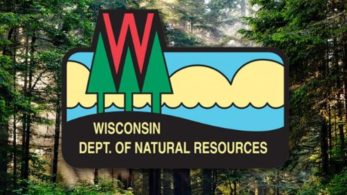Five lucky resident hunters getting ready for Wisconsin’s second managed elk hunt
Contact(s): Kevin Wallenfang, DNR deer and elk ecologist, 608-206-1107
MADISON – Following a 30-day application period, the Wisconsin Department of Natural Resources conducted the random drawing for four lucky residents who will have the opportunity to participate in the 2019 elk hunting season.

Dan Vandertie with a bull elk harvested in Wisconsin’s first managed elk hunt in November 2018. Five more hunters will have the chance to pursue elk this fall.Photo credit: Dan Vandertie
“I would like to sincerely thank all those who applied for an elk license,” said Kevin Wallenfang, DNR deer and elk ecologist. “It was a privilege to call all the winners and personally congratulate them. Each one recognizes that this will be a unique and exciting experience.”
Over 23,000 Wisconsin residents entered the drawing for one of four once-in-a-lifetime elk tags. The winners were from the cities of Cameron, Cumberland, Grand View and Medford. The fifth license has already been awarded through a raffle conducted by the Rocky Mountain Elk Foundation. The winner was drawn at the RMEF state banquet in Wausau on June 1 and is from Hazel Green.
Although the number of applicants is down from last year, the funding brought in through this application process as well as the additional $7,800 that was donated, will be used to support habitat management and research to benefit Wisconsin’s growing elk population and a variety of other wildlife as well.
“Last year’s hunters collected some very nice bulls and great stories of the hunt, so we’re looking forward to continued success within the elk program that provides more hunting and elk viewing opportunities in the future,” said Wallenfang.
Wallenfang adds that the hunt has brought a new level of awareness to many people who were unaware that Wisconsin has elk in the state. “Elk viewing, especially in the fall, is adding a welcomed boost to local communities as people travel to hear elk calls and catch a glimpse of elk in their natural habitat.”
The 2019 elk hunting season will occur only in the Clam Lake elk range in parts of Sawyer, Bayfield, Ashland and Price counties in far north-central Wisconsin where the original restoration effort was initiated with 25 elk from Michigan in 1995.
The herd is projected to be as high as 230 animals this year, not including more than 50 elk that are currently in quarantine as part of the final year of reintroduction efforts. Those elk will not be allowed for harvest during this year’s hunt.
For more information regarding elk in Wisconsin, go to dnr.wi.gov and search keyword “elk.” To receive email updates regarding current translocation efforts, visit dnr.wi.gov and click on the email icon near the bottom of the page titled “subscribe for updates for DNR topics.” Then follow the prompts and select the “elk in Wisconsin” and “wildlife projects” distribution lists.
________________________
Wisconsin’s wolf population remains healthy, stable
Contact(s): Scott Walter, DNR large carnivore specialist, (608) 267-7865
MADISON – Extensive monitoring efforts by more than 100 volunteer trackers and Department of Natural Resources staff suggest that Wisconsin’s wolf population is stable while remaining well above established population goals. Data collected during track surveys this past winter reveal an overwinter minimum wolf count of 914-978 wolves, similar to the 905-944 wolves detected during the 2017-2018 count. The state’s wolf population had been increasing steadily since the early 1990s but appears to have stabilized over the last few years. The number of wolf packs detected during surveys increased slightly, from 238 packs last year to 243 this past winter.

A gray wolf. This winter’s minimum wolf count showed stable population numbers.Photo credit: DNR
Wolf surveys are conducted annually during winter when snow cover affords suitable tracking conditions. At that time of year, the wolf population is at its lowest point, so the results of these surveys are considered minimum counts. The population increases every spring with the birth of pups, then declines throughout the remainder of the year due to dispersal and various mortality factors.
Although wolves remain classified as endangered under the Federal Endangered Species Act, the U.S. Fish & Wildlife Service recently proposed removing wolves from the endangered species list. Such a move would restore management authority to the state and allow a more flexible approach to wolf management.
“While we can credit the Endangered Species Act with allowing wolves to regain their important role in our wildlife community, there’s simply no biological rationale for maintaining current federal protections. Delisting would allow managers a fully-integrated set of management tools with which to address issues such as the depredation of livestock and pets,” noted DNR large carnivore specialist Scott Walter.
To view a summary of wolf monitoring information and to learn more about wolves in Wisconsin, visit dnr.wi.gov and search keyword “wolf.” To learn more about the volunteer tracking program and opportunities to participate, search keywords “wolf volunteer tracking.” Classes for new volunteer wolf trackers will be held during fall of 2019.
You may also like
-
Pennsylvania Governor Josh Shapiro Signs Legislation Repealing Sunday Hunting Ban
-
Evers Administration And Ducks Unlimited Announce New Wetland Project In Brillion State Wildlife Area
-
Help Amplify ATV/UTV Safety Messaging Ahead Of Holiday Weekend
-
DNR Seeking Landowners To Host Fall Gun Deer Hunt For Hunters With Disabilities
-
Find Your Next Outdoor Adventure In Wisconsin During Free Fun Weekend, June 7-8
